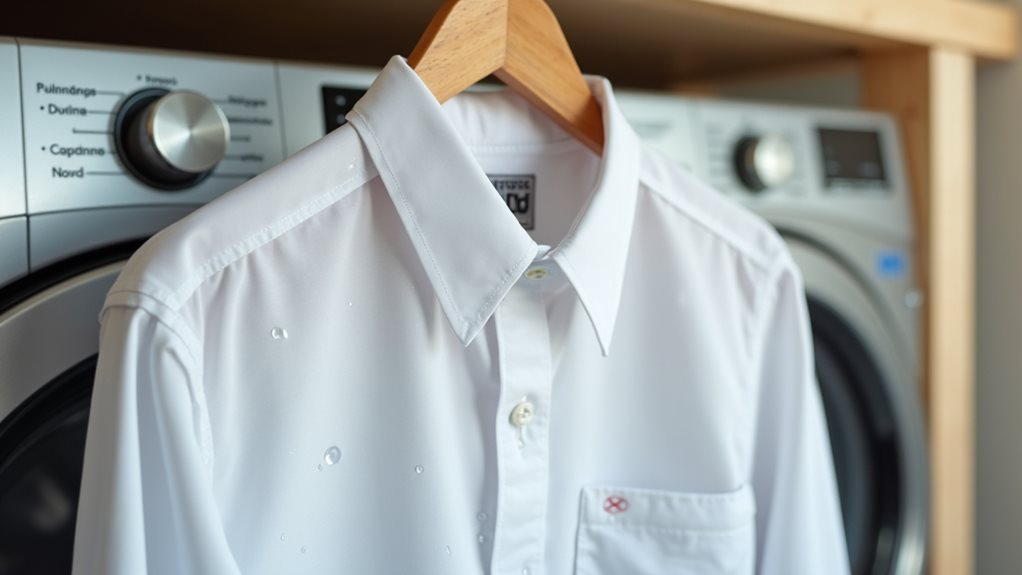You can wash some “dry clean only” garments at home, though it’s honestly a bit like playing fabric roulette – sometimes you win, sometimes you don’t. I’ve learned that spot testing in hidden areas first saves heartbreak, while hand washing with cool water and mild detergent works surprisingly well for items like silk blouses and wool sweaters. The key lies in gentle techniques, proper drying methods, and knowing which pieces are worth the risk versus those expensive structured blazers that’ll never forgive you.
Understanding Care Labels and Fabric Types
Why do those tiny care labels always seem to hide in the most inconvenient spots, tucked away like secret messages that hold the key to your garment’s survival?
I’ve learned the hard way that these care labels aren’t suggestions—they’re survival guides for your favorite pieces. When you see “dry clean only clothes” stamped on that label, it’s because the fabric type simply can’t handle water’s aggressive nature.
Your delicate items, like silk blouses or wool blazers, need professional attention because their fibers will shrink, fade, or lose their shape faster than you can say “oops.”
Delicate fabrics demand professional care—one wrong wash and your favorite silk blouse becomes an expensive mistake.
Understanding washing instructions means recognizing that hand washing might work for some borderline cases, but respecting those crossed-out washing symbols will save you heartbreak.
Items with intricate details or special finishes require professional dry cleaning services to maintain their quality and appearance.
What Dry Clean Only Items Should Never Be Washed at Home
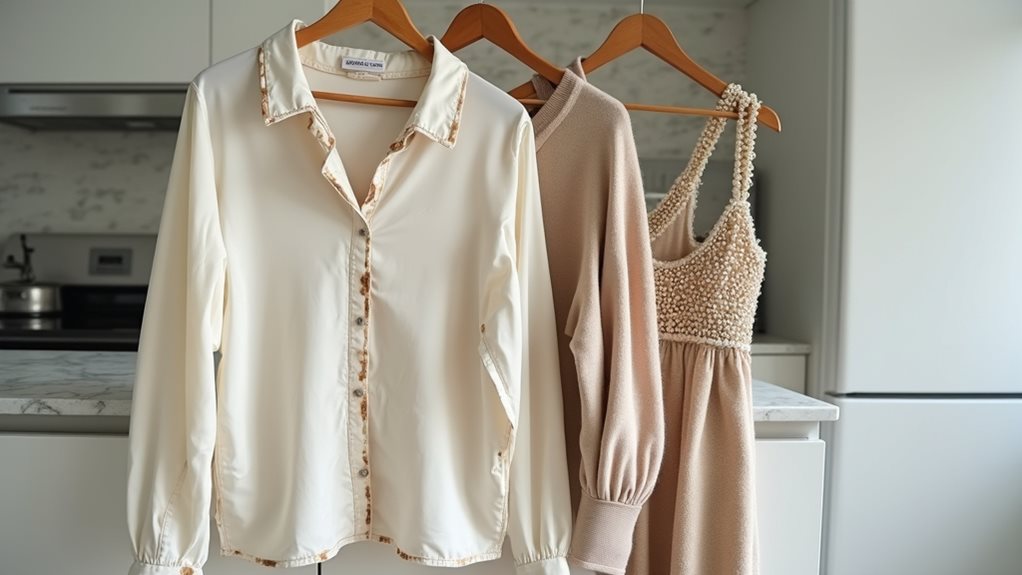
Some garments are like high-maintenance friends who look absolutely stunning but require special care, and attempting to wash them at home is fundamentally signing their death warrant.
Your vintage beaded tops, with their intricate embellishments, can’t survive machine washing or even gentle hand washed treatment—those delicate beads will scatter like confetti 🎉.
Real fur garments absolutely despise water, losing their luxurious texture permanently when you try to clean at home.
Suede items transform into sad, misshapen shadows of their former selves, while rayon shrinks faster than your motivation on Monday mornings.
Items with delicate details, like structured blazers or manufactured pleating, need professional expertise to maintain their sophisticated silhouette.
Delicate fabrics like silk, wool, and cashmere also require professional dry cleaning to preserve their quality, as these materials are particularly prone to color bleeding and shrinkage when exposed to water.
Trust me, your dry clean only clothing deserves that professional pampering.
Spot Testing Before Washing Delicate Garments
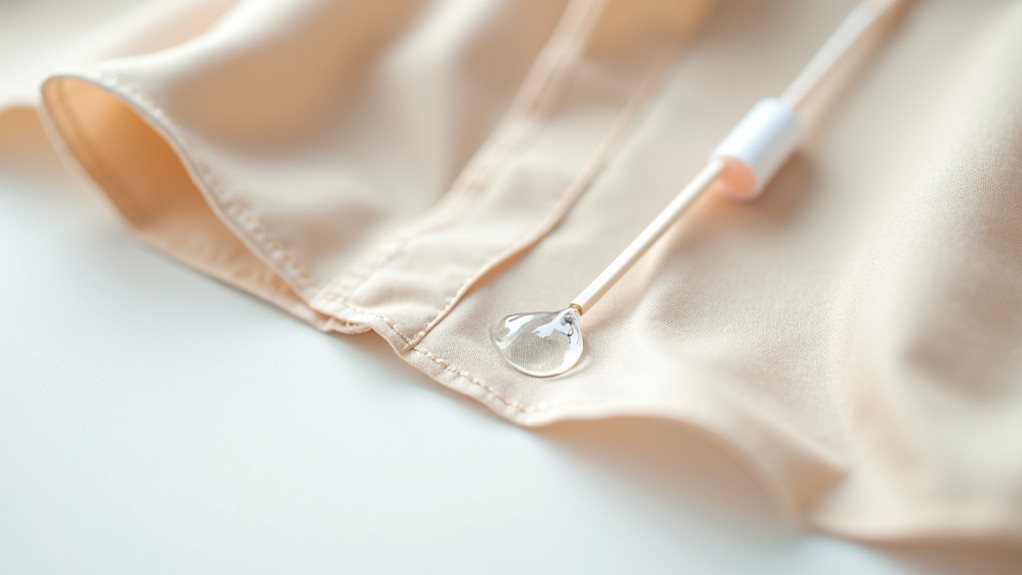
Before you take the plunge with that “dry clean only” blazer you’ve been eyeing for a home wash, you’ll want to become best friends with the spot test—trust me, I learned this the hard way after turning a gorgeous burgundy sweater into a tie-dye disaster 😅.
The key is finding those sneaky hidden areas like inside seams or underneath collars where you can safely test for colorfastness without anyone being the wiser if things go sideways.
Think of it as your garment’s dress rehearsal, because once you know how your fabric behaves with water and detergent in a small, controlled area, you’ll have the confidence to decide whether that full wash is worth the risk.
Besides protecting your favorite pieces from washing mishaps, spot testing helps you avoid the health risks associated with frequent exposure to traditional dry cleaning chemicals like perchloroethylene.
Colorfastness Testing Methods
When you’re staring at that gorgeous silk blouse with the dreaded “dry clean only” label, wondering if you can risk a gentle home wash, colorfastness testing becomes your best friend and potential heartbreak preventer.
Mix a tiny amount of mild detergent with water at room temperature, then apply it to an inconspicuous area using a Q-tip or white washcloth. This test first approach helps you assess whether the fabric will bleed or fade during washing.
Blot the tested spot with a clean white cloth, checking for any color transfer that might indicate bleeding issues. Let the area dry completely before inspecting for discoloration or fading.
If you notice any color changes, stick with dry cleaning to preserve your garment’s integrity.
Keep in mind that traditional dry cleaning uses PERC, a chemical solvent that can pose health risks, so always allow freshly dry cleaned items to air out before wearing them.
Safe Test Areas
Where exactly should you perform this essential spot test, and how can you choose the perfect hidden location that won’t leave you with an obvious disaster if things go wrong? Always test first on areas that won’t betray your experimental washing adventure if delicate fabrics decide to react poorly.
- Inner seams – These hidden heroes protect your reputation when tagged items throw tantrums.
- Hem undersides – Perfect secret spots where garments perform their color-bleeding drama privately.
- Side seam allowances – Your safety net when dry clean only labels weren’t kidding around.
- Under collar areas – Concealed zones that’ll save you from obvious fashion failures.
I learned this lesson after spot testing a silk blouse’s front pocket (rookie mistake!), which left a permanent reminder of my overconfidence.
Choose wisely, test thoroughly, and your delicate treasures will thank you. Remember that if you’re wearing specialized work attire that requires professional dry cleaning, maintaining proper care documentation could potentially qualify as a business expense depending on your employment situation.
Hand Washing Methods for Dry Clean Only Clothes
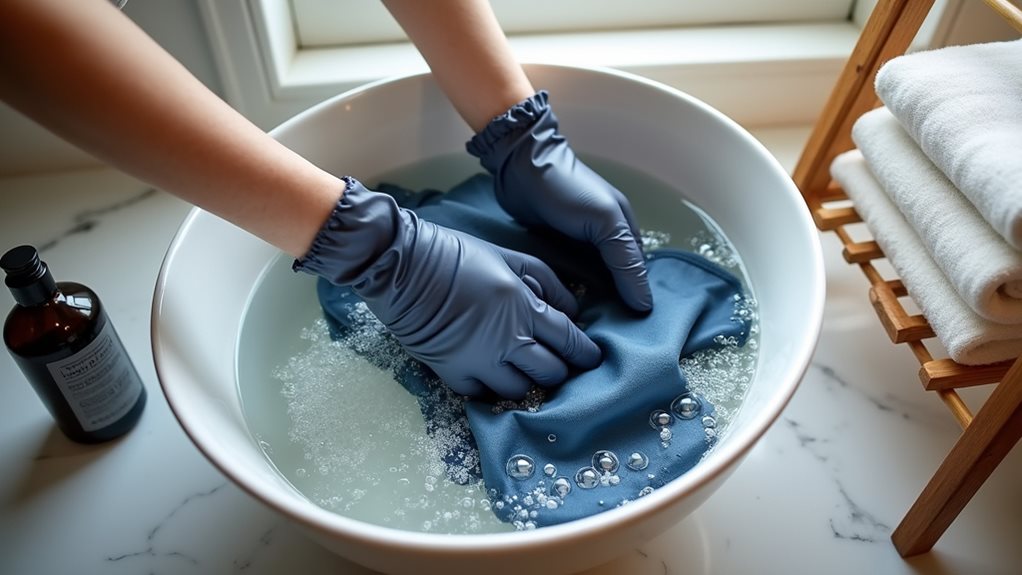
Three simple steps can transform your approach to hand washing those intimidating “dry clean only” garments, though I’ll admit I learned this the hard way after accidentally shrinking my favorite cashmere sweater into doll-sized proportions 😅.
First, you’ll want to fill a basin with cool water and add a mild detergent specifically designed for delicate fabrics, creating a gentle soaking solution that won’t assault the fibers.
Next, submerge your garment for up to thirty minutes, resisting the urge to scrub or agitate because patience truly becomes your best friend here.
Finally, remove excess water by pressing down gently rather than wringing, then roll the item in a clean towel before laying it flat to dry naturally.
Before attempting any home cleaning method, always test on an inconspicuous area first to ensure the fabric care labels are accurate and your garment won’t suffer unexpected damage.
Machine Washing Techniques Using Gentle Cycles
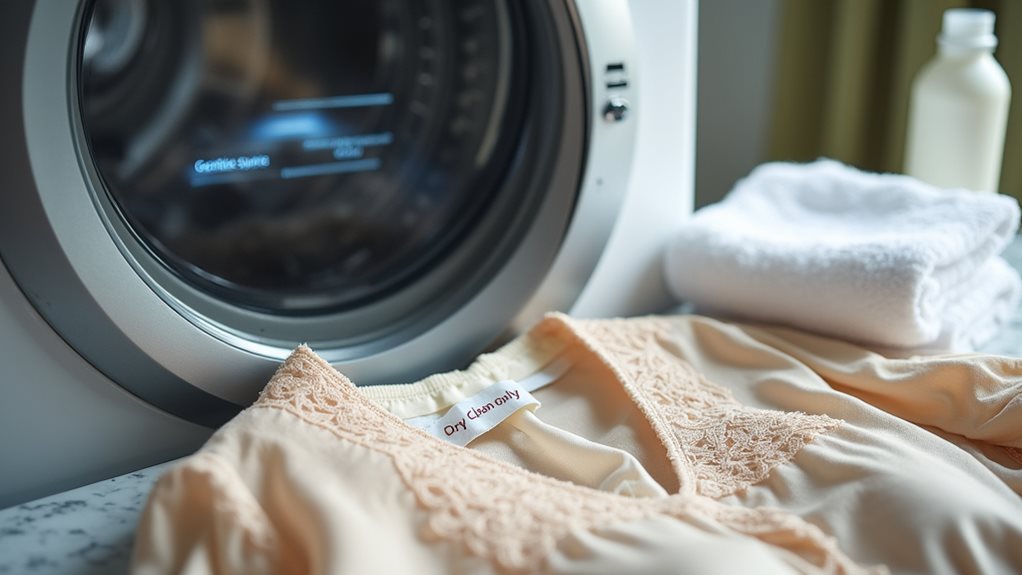
If you’re feeling brave enough to try machine washing those “dry clean only” treasures, you’ll want to treat your washing machine like a gentle spa day rather than a wrestling match.
Cold water becomes your best friend here, since hot water can turn your favorite blazer into doll clothes faster than you can say “oops,” and I’ve learned this lesson the expensive way more times than I care to admit 😅.
Investing in a good mesh laundry bag might seem like overkill, but trust me, it’s like giving your delicate garments a protective bubble that prevents them from getting tangled, stretched, or beaten up by heavier items during the wash cycle.
While many people worry about the safety of dry cleaning chemicals, occasional exposure to professionally cleaned garments poses minimal risk, though it’s still wise to let freshly dry cleaned clothes air out before wearing them.
Cold Water Settings
- Always check care labels first—some items truly aren’t machine-washable candidates.
- Use a protective mesh bag to shield delicate fabrics from aggressive tumbling.
- Select the gentle or delicate cycle paired with cold water for ideal protection.
- Turn garments inside out before washing to minimize surface damage and pilling.
- Keep detailed receipts for dry cleaning expenses on work uniforms, as these may be tax-deductible if the clothing cannot be worn for everyday purposes.
- Lay flat on clean towels to maintain the garment’s natural shape and prevent stretching
- Gently roll in towels to absorb excess water instead of wringing or twisting the fabric
- Hang carefully using padded hangers for items that won’t stretch under their own weight
- Support structured pieces with additional towels or forms to maintain their intended silhouette
Mesh Bag Protection
Beyond temperature control, you’ll want to arm yourself with one of the most underrated heroes in the delicate laundry game: the humble mesh bag.
These protective little warriors create a gentle barrier between your precious dry clean clothes and the aggressive tumbling of your wash cycle, preventing those heartbreaking snags that’ll make you question every life choice 😅.
Before tossing delicate items inside, flip them inside-out and zip up any zippers – trust me, I’ve learned this the hard way after finding my favorite blouse twisted into origami.
Choose appropriately sized bags to avoid overcrowding, which defeats the purpose entirely.
Once your gentle cycle finishes, immediately remove everything to hang or lay flat, because leaving them bunched up creates stubborn wrinkles.
This method works particularly well for items like beaded garments or sequined pieces that would otherwise suffer damage from the machine’s movement.
Proper Drying Methods to Prevent Damage
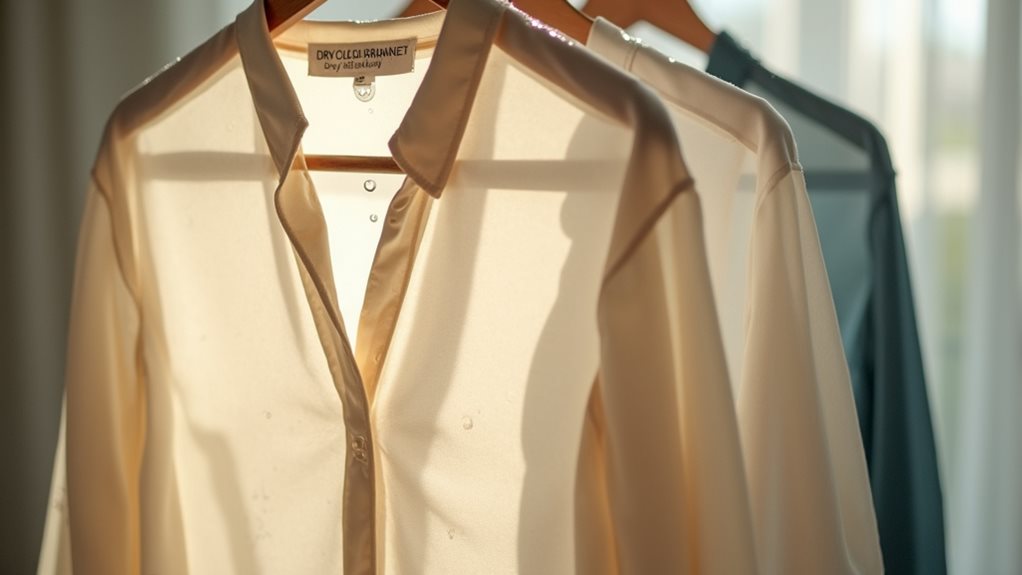
Once you’ve successfully washed your dry clean only garment, the drying process becomes absolutely essential for preserving its integrity. I learned this lesson the hard way when I accidentally turned my favorite silk blouse into what looked like doll clothes after one unfortunate encounter with my dryer.
Here’s how to air dry your delicate garments without ruining them:
Proper drying methods prevent irreversible damage that heat can cause to delicate fibers. Quick drying is especially important for dry cleaned items to prevent water spots, shrinkage, or color bleeding that can occur when moisture lingers on the fabric.
Alternative Cleaning Options and Home Dry Cleaning Kits

While professional dry cleaning remains the gold standard for delicate garments, I’ve discovered that home dry cleaning kits can be absolute lifesavers when you’re dealing with lightly soiled garments or simply need to rejuvenate that wool sweater that’s developed a slight mustiness from hanging in your closet too long.
These alternative cleaning options typically include milder solutions and fabric sheets that work magic in your dryer, removing odors and wrinkles without the harsh chemicals.
However, I’ll be honest—they’re not miracle workers for heavily stained items, so save professional cleaning for those wine spills!
When you’re unsure about tackling delicate fabrics, fabric sprays designed specifically for gentle rejuvenation can work wonders, giving you that “just cleaned” feeling without any washing risks whatsoever.

